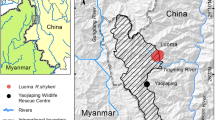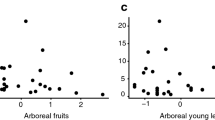Abstract
Spider monkeys (Ateles spp.) are well known for their highly arboreal lifestyle, spending much of their time in the highest levels of the canopy and rarely venturing to the ground. To investigate terrestriality by Ateles and to illuminate the conditions under which spider monkeys venture to the ground, we analyzed ad libitum data from 5 study sites, covering 2 species and 5 subspecies. Three of the sites are in Central/North America: Barro Colorado Island (BCI), Panama (Ateles geoffroyi panamensis), Santa Rosa National Park, Costa Rica (A. g. frontatus), and Punta Laguna, Mexico (A. g. yucatanensis). The 2 remaining sites are in South America: Cocha Cashu Biological Station, Perú (A. belzebuth chamek) and Yasuni National Park, Ecuador (A. b. belzebuth). Terrestrialism by Ateles at all sites is rare; however, it is more restricted at the 2 South American sites. In South America, ground use only occurred in the contexts of eating soil or rotten wood and visiting salt licks. In contrast at the 3 sites with Ateles geoffroyi it rarely occurred in a feeding context, but instead more frequently while drinking from streams during the dry season, by adult females escaping attack by adult males, and as part of a chase game. In addition, on BCI adult males were on the ground before attacking adult females. We discuss potential explanations, e.g., climate, species differences, predation pressure, for the differences between the Central/North and South American observations.
Similar content being viewed by others
References
Altmann, J. (1974). Observational study of behavior: Sampling methods. Behaviour 49: 227–267.
Boinski, S. (1989). The positional behavior and substrate use of squirrel monkeys: Ecological implications. J. Hum. Evol. 18(7): 659–677.
Chapman, C. A. (1988). Patterns of foraging and range use by three species of Neotropical primates. Primates 29: 177–194.
Coelho, A. M., Jr., Bramblett, C. A., and Quick, L. B. (1976). Resource availability and population density in primates: A socio-bioenergetic analysis of the energy budgets of Guatemalan howler and spider monkeys. Primates 17: 63–80.
Dew, J. L. (2005). Foraging, food choice, and food processing by sympatric ripe-fruit specialists, Humboldt's woolly monkey and the white-bellied spider monkey. Int. J. Primatol. 26: 1107–1135.
De Souza, L., Ferrari, S. F., Da Costa, M. L., and Kern, D. C. (2002). Geophagy as a correlate of folivory in red-handed howler monkeys (Alouatta belzebul) from Eastern Brazilian Amazonia. J. Chem. Ecol. 28(8): 1613–1621.
Di Fiore, A. (2002). Predator sensitive foraging in the ateline primates. In Miller, L. (ed.), Eat or be Eaten: Predator Sensitive Foraging Among Primates. Cambridge University Press, Cambridge, pp. 242–267.
Di Fiore, A., and Rodman, P. S. (2001). Time allocation patterns of lowland woolly monkeys (Lagothrix lagotricha poeppigii) in a neotropical terra firma forest. Int. J. Primatol. 22: 449–480.
Emmons, L. H., and Feer, F. (1990). Neotropical Rainforest Mammals: A Field Guide. The University of Chicago Press, Chicago.
Fleagle, J. G. (1999). Primate Adaptation and Evolution. Academic Press, London.
Freese, C. H., and Oppenheimer, J. R. (1981). The capuchin monkeys, genus Cebus. In Coimbra-Filho, A. F., and Mittermeier R. A. (eds.), Ecology and Behavior of Neotropical Primates. Academia Brasileira de Ciencias, Rio de Janeiro, pp. 331–390.
Glanz, W. E. (1982). The terrestrial mammal fauna of Barro Colorado Island: Censuses and long-term changes. In Leigh, E. G., Rand, A. S., and Windsor, D. M. (eds.), Ecology of a Tropical Forest. Smithsonian Institution Press, Washington, DC, pp. 455–468.
Heymann, E. W., and Hartmann, G. (1991). Geophagy in moustached tamarins, Saguinus mystax (Platyrrhini: Callitrichidae), at the Río Blanco, Peruvian Amazonia. Primates 2(4): 533–537.
Izawa, K. (1993). Soil-eating by Alouatta and Ateles. Int. J. Primatol. 14(2): 229–242.
Karesh, W. B., Wallace, R. B., Painter, R. L. E., Rumiz, D., Braselton, W. E., Dierenfeld, E. S., and Puche, H. (1998). Immobilization and health assessment of free-ranging black spider monkeys (Ateles pansicus chamek). Am. J. Primatol. 44: 107–123.
Klein, L. L., and Klein, D. B. (1977). Feeding behaviour of the Colombian spider monkey. In Clutton-Brock, T. H. (ed.), Primate Ecology: Studies of Feeding and Ranging Behaviour in Lemurs, Monkeys and Apes. Academic Press, London.
Klein, L. L. (1972). The Ecology and Social Behavior of the me Spider Monkey, Ateles belzebyth. Ph.D. Dissertation, University of California Berkeley.
Leigh, E. G. Jr. (1999). Tropical Forest Ecology: A View From Barro Colorado Island. Oxford University Press, New York.
Miller, L. (2002). The role of group size in predator sensitive foraging decisions for wedge-capped capuchin monkeys (Cebus olivaceus). In Miller, L. (ed.), Eat or be Eaten: Predator Sensitive Foraging Among Primates. Cambridge University Press, Cambridge, pp. 95–106.
Müller, K. H., Ahl, C., and Hartmann, G. (1997). Geophagy in masked titi monkeys (Callicebus personatus melanochir) in Brazil. Primates 38(1): 69–77.
Napier, J. R., and Napier, P. H. (1985). The Natural History of the Primates. MIT Press, Cambridge, Massachusetts.
Russo, S. E., Campbell, C. J., Stevenson, P. R., and Suarez, S. A. (2005). Multiforest Comparison of Dietary Preferences and Seed Dispersal by Ateles spp. Int. J. Primato. 26: 1017–1037.
Setz, E. Z. F., Enzweiler, J., Solferini, V. N., Amêndola, M. P., and Berton, R. S. (1999). Geophagy in the golden-faced saki monkey (Pithecia pithecia chrysocephala) in the Central Amazon. J. Zool. Lond. 247: 91–103
Symington, M. M. (1987). Ecological and Social Correlates of Party Size in the Black Spider Monkey, Ateles paniscus chamek. Ph.D. Thesis. Princeton University, Princeton.
Terborgh, J. (1983). Five New World Primates. Princeton University Press, Princeton, New Jersey.
Van Roosemalen, M. G. M. (1985). Habitat preferences, diet, feeding strategy and social organization of the black spider monkey (Ateles paniscus paniscus Linnaeus 1758) in Suriname. Acta Amizonica. 15, suppl. 3/4: 3–238.
Wright, S. J., Gompper, M. E., and DeLeon, B. (1994). Are large predators keystone species in Neotropical forests? The evidence from Barro Colorado Island. OIKOS, 71: 279–294.
Youlatus, D. (2002). Positional behavior of black spider monkeys (Ateles paniscus) in French Guiana. Int. J. Primatol. 23(5): 1071–1094.
Author information
Authors and Affiliations
Corresponding author
Rights and permissions
About this article
Cite this article
Campbell, C.J., Aureli, F., Chapman, C.A. et al. Terrestrial Behavior of Ateles spp. Int J Primatol 26, 1039–1051 (2005). https://doi.org/10.1007/s10764-005-6457-1
Received:
Revised:
Accepted:
Issue Date:
DOI: https://doi.org/10.1007/s10764-005-6457-1




